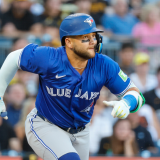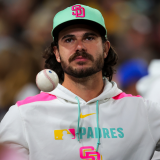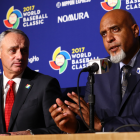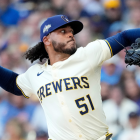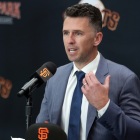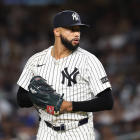Giants, A's off to scorching second-half starts; robot umps are close and everything else we learned this week in MLB
Here's what you need to know from the last seven days of MLB action
We'll be taking a look at the most interesting takeaways every week this MLB season so check back every Sunday for our recap. Now, here's what we learned from the last seven days in MLB:
Deja vu in Oakland
The Oakland Athletics have been one of the hottest teams in baseball since the All-Star break. Entering Sunday, they've gone 7-1 in the second half, a run sparked by a six-game winning streak.
It's deja vu for the A's as what's happening now is awfully similar to their run to the playoffs last season. Once again, Oakland will have to decide whether or not they'll stick with their Moneyball strategy. If they do, they'll likely grab a couple of bargains (probably focusing on starting pitching) at the trade deadline. They already added veteran starter Homer Bailey to their rotation.
The A's currently have the fifth-best run differential in baseball, and their plus-98 mark only sits behind the Dodgers, Yankees, Twins and Astros. While Khris Davis isn't matching his league-best 48 home run season of last year, Oakland's Matt Chapman and Matt Olson have been anchors to this team's lineup. Oakland's team batting average (.251) and team on base percentage (.324) rank in the middle of the pack in the league. And as far as pitching goes, Brett Anderson and Mike Fiers are both within one game of reaching the double-digit mark in the win column, and each sports an ERA under 4.00. The loss of right-hander Frankie Montas to an 80-game suspension for the use of performance-enhancing drugs was a big hit to the team's rotation. Montas won't be eligible to return until the end of September. If the A's plans to not only make, but advance in the postseason, they'll have to strengthen their rotation.
With the team's pitching needs, Billy Beane's Moneyball approach will be put to the test once again at this year's trade deadline. The A's have the 26th-lowest payroll in MLB; they're spending just around $90 million on players this season. The only other team that has a good chance at making the postseason that's spending less are the Tampa Bay Rays, who have a payroll of just $62 million. The defending World Series champion Red Sox, who are trailing the A's as well as the Indians and Rays for an AL Wild Card spot, have a payroll of nearly $230 million.
As of Sunday, the Athletics managed to take two of three games from the Twins and once that four-game series wraps up, they'll face another tough road series against the Astros.
Giants' surge makes for a tough deadline decision
The San Francisco Giants were supposed to be big sellers at this year's one and only MLB trade deadline, but things are now much more complicated because of their recent surge. This past week, the Giants won seven consecutive games (two of which were walk-off wins) for their longest winning streak in three seasons.
The question of to sell or not to sell will be what keeps president of baseball operations Farhan Zaidi up at night for the next 10 days. It's a tough call because on one hand, yes, the Giants are nearing the second NL Wild Card spot... But on the other hand, it's highly unlikely that the team can keep up their hot streak and manage to hang onto the Wild Card through the end of the season (Sportsline has their playoff odds at five percent), plus Zaidi's plan all along has been to rebuild this team, which means selling any valuable assets (i.e. Madison Bumgarner, Will Smith) for a good amount of young talent. Ultimately, it just makes more sense to restock the team's mediocre farm system with a batch of quality prospects. The small chance of this team being a playoff contender is not worth risking out on the chance to load up for the team's future.
So in this scenario, for Giants fans at least, it's honestly a double-edged sword. If the team sells, fans will likely miss out on a chance of an exciting second half of the season. But if the team decides to hold, fans will get to watch a playoff hunt, but the Giants might be worse off in the long run.
The Giants would have to essentially play like they've been playing this past week to move their way up the standings. As of Sunday, they are 2 1/2 games back of the second NL Wild Card spot. They're currently behind five teams Nationals, Brewers, Cardinals, Phillies and NL West rival Diamondbacks. They have one of the toughest National League schedules in the second-half, and during the month of August, the Giants will have to face the Phillies, Nationals and Diamondbacks. It's just hard to see the Giants stacking up against teams that just have more talented lineups than them at the moment. Either way, whatever ends up happening, July 31 will be an interesting day for Giants fans.
The robot umpire era is here
This month saw the debut of the electronic strike zone in the independent Atlantic League. The use of Atlantic League "robot umps" is one of many experimental rule changes that are part of a three-year agreement with Major League Baseball. The robot umpire is actually a system that uses the TrackMan, a network of calibrated lasers that work to call strikes and balls that (if all goes well) are accurate to each hitter's unique strike zone.
TrackMan doesn't evaluate checked swings and it deems a bounced ball as a strike, so the need for real, live umpires isn't completely eliminated. But the ultimate goal of using an electronic strike zone is to lessen the chance of a wrong call. Speaking of which, during the Marlins-Padres game on Wednesday, Curtis Granderson was at-bat with Miami down to its last out in the ninth inning, down by one run with two men on base. The home plate umpire called a pitch from Padres reliever Kirby Yates a strike, when it appeared to be out of the zone.
After the game, Marlins manager Don Mattingly referenced the electronic strike zone that recently was implemented in the Atlantic League. "Those things (robot umps) are going to happen, it almost has to happen. It's moving, and hopefully the technology gets there quick," Mattingly told reporters after the one-run loss.
We're definitely a long way from the TrackMan system being fully implemented in MLB, but Mattingly does have a point. If the experiment with the electronic strike zone in the Atlantic League goes well and manages to work out all the kinks, it could make for a huge improvement as far it pertains to the major-league strike zone.




